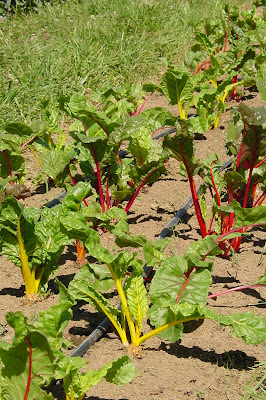The big board on the left is detailing the week's food, and there's a sign-in sheet on the table. There are two pickups per week (you choose which day you want) and enough food is picked throughout the day to account for the number of shares expected.
Below, the board on the left is listing which herbs are available to pick and where they are - in the Hoope House, between the barn doors, at the rock pile, or in a bed. The middle board is a map of the farm with numbered/named beds. The last board has notices of relevant events or workshops at the farm or in the area.
Up first, Chinese cabbage, broccoli, lettuce, zucchini, cucumbers, carrots, and beets.
We are also able to order from a variety of local producers for items like chickens, dairy, eggs, coffee, and bread. (Of course the coffee is not grown here but sourced responsibly and roasted here. I figured I'd qualify that before someone called me on it!) Keep in mind, the word dairy, for example covers ice cream and milk, and bread can mean amazing granola, whole grain bread, or cookies. Some items must be ordered a week ahead, and others are available for impulse purchasing.
CSA's are a good idea all the way around, from supporting local industry and protecting the land to providing all of us with just-picked healthy food for our families. Yes, my family has learned to eat, or at least try, some unfamiliar vegetables but let's face it, it's a vegetable. There are differences in each CSA, they have varying levels of involvement (read: working in the beds), may or may not be organic, may have an orchard, or may partner with other farms to offer even greater variety.
A google search will result in lots of information, but Local Harvest is a good place to start. There's a CSA search by zip and a lot of good information. If you are local, you've probably seen the pretty Buy Fresh Buy Local logo on bumper stickers and store windows. Their website lists "1555 (and counting) places to find local food" and is a good source of restaurants, farmer's markets, grocery stores, csa's,etc. If you can get your hands on a bumper sticker they really are gorgeous.
Writing this post reminds me that I have added a few good vegetable books to my cookbook shelves, and I will review them soon. In the meantime, I'll share a greens suggestion. The "green leafy vegetables" referred to everywhere actually mean big leafy greens like kale or chard, and not a salad of Iceberg lettuce. (Sorry.) Having the greens in the fridge does not guarantee their consumption, but I have found that having a container of cooked greens does.
For this you will need:
A large skillet with a lid
Onions, garlic, olive oil (or other, as you like)
A couple of bunches of greens
- Wash and tear as many greens as you have on hand. I combine the longer cooking ones (collards, spinach, and kale, for example) or the more tender ones (Swiss chard and beet greens) into one batch. It is a good idea to fill a large bowl or the sink with cool water, soak and swish the greens, then let everything settle before lifting them gently from the water. There's no need to spin them or blot much before cooking, just shake them over the water and make a lovely pile on a clean towel.
- Depending on your taste, either start an onion/garlic/olive oil saute, or soften an onion/garlic mixture in a half cup of water and a splash of olive oil by simmering for a few minutes. The saute will produce a stronger taste while the simmer will take the bite out of the garlic. Try both and you may find that one method suits a bitter green, and one a milder type.
- Add the damp greens, a handful or two at a time, and stir. They will quickly reduce in volume, allowing you to keep adding the rest of your pile.
- Cover the pan and simmer for anywhere from 5 to 20 minutes, depending on the greens. Your goal is a forkful of tender greens. Add water to the pan as needed, and be careful to keep them from burning.
- When they are finished add salt and a lot of freshly ground pepper. A splash of balsamic vinegar is nice if you want to serve them right away, otherwise, store them covered in the fridge.
















